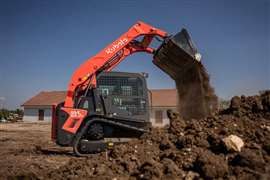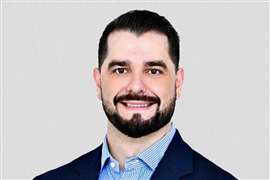Future plans, R&D and product development: How Briggs & Stratton is bouncing back
18 November 2021
CEO Steve Andrews puts focus on the future at ‘the new Briggs & Stratton’ after its acquisition by KPS Capital Partners. Mike Brezonick reports.
One of the very first moves private equity firm KPS Capital Partners made after acquiring Briggs & Stratton from Chapter 11 bankruptcy in late September of 2020 was name Steve Andrews president and CEO.
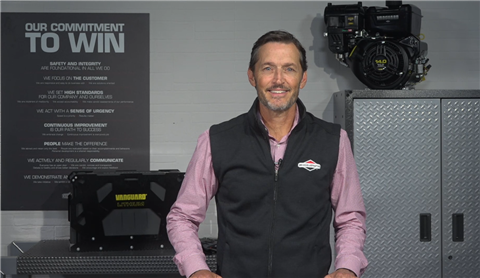 Briggs & Stratton CEO Steve Andrews is using the Commitment to Win values to plan a brighter future for the 113-year-old manufacturer that went through bankruptcy in 2020.
Briggs & Stratton CEO Steve Andrews is using the Commitment to Win values to plan a brighter future for the 113-year-old manufacturer that went through bankruptcy in 2020.
In handing the reins of the troubled, but still iconic engine and power products manufacturer to Andrews, KPS was banking on experience. Andrews and KPS had partnered in 2011 to form International Equipment Solutions, LLC (IES), which Andrews helped build into a global supplier of machine attachments, cabs and other products for off-highway applications before it was divested by KPS.
Even before that, Andrews had significant industry knowledge, serving as president and CEO of Pettibone LLC, a group of industrial businesses that included heavy equipment manufacturers Pettibone Traverse Lift and Barko Hydraulics from 2007 to 2011 and spending 13 years as vice president and general manager of axle and suspension specialist Hendrickson. The Jackson, Mich., native, who began his career at powertrain systems specialist Dana, sat down with Diesel Progress recently to talk about his first year at Briggs & Stratton and what he sees as a bright future for the company.
You took over a company that had gone through bankruptcy. What was your message to people when you got there?
Andrews: The message that I gave to people was, this is a company with a very proud past and we’ll learn from our past, but it’s all eyes forward. We spent a lot of time talking about ‘eyes forward’ and the future of the company and the opportunities that exist for us. And there are many.
The other message was that this is going to be a company that’s going to do some things differently than we had in the past, have a different level of emphasis in certain areas, like R&D, like new product development – that’s really what we are, a product company. We’re going to lean into the trends in our industry such as electrification, we’re not going to be defensive about them, and we’re going to make sure that we’re appropriately focused in those areas that provide the greatest opportunity for us.
And we’re going to execute like hell to make sure that this continues to get back to being a thriving, successful company for decades to come.
How difficult was it for you to send that message when, because of COVID, you couldn’t be there as much as you usually would have been?
Andrews: It was interesting. We have roughly 700 to 750 salaried employees in the Milwaukee area and the vast majority of them, of course, were working remotely when I joined and when KPS took ownership in September of 2020. We did as much as we could with getting limited groups of people together, socially distanced here at the headquarters. We did a lot of communication sessions over video, both recorded sessions and live feed sessions, with our roughly 5000 employees worldwide.
 Along with engines and batteries, Briggs & Stratton is maintaining its stable of power products such as Ferris, which manufactures a range of commercial mowers and equipment.
Along with engines and batteries, Briggs & Stratton is maintaining its stable of power products such as Ferris, which manufactures a range of commercial mowers and equipment.
It was very important to me to interact with the team at Briggs as much as I possibly could to understand the business, the strengths and weaknesses, to assess the culture, and then to make sure that we were establishing and communicating the culture that we want to exist in the business going forward. That’s what led to Our Commitment to Win values.
It’s something that’s foundational to me in every business that I’ve been involved with. To me, it’s fundamental to establish the cultural values that we believe are important in the company and become the basis to drive our behaviors and actions and areas of focus going forward.
You’ll see it in every conference room, you’ll see it in most offices, you’ll see it in all of our locations worldwide. We’ve said that, first and foremost, Our Commitment to Win values are essential to how this company is going to operate going forward and we are unapologetic about driving those values across the business on a global basis.
What was your message to Briggs & Stratton customers?
Andrews: I’ve met with CEOs and senior executives of virtually all of our customers. I shared with them that first and foremost, Briggs & Stratton is in a radically different position today than this company was 12 months ago from a financial standpoint. And given the financial position of the company today, that Briggs & Stratton is here for the for the long term and that we’re placing a very high level of focus on product technology, new product development and high levels of customer support.
I’ve told them all that over the next several years, I hope that they’re able to look back and be pleasantly surprised with the amount and level of new technology that we are bringing to them going forward. That’s a critical area of focus and we have the ability to make investments – that includes investments in people, that includes investments and plant and equipment, that includes investments in technology and that includes investments in partnerships and acquisitions - to accelerate our product roadmap that the company wasn’t able to make a year ago or over the past several years due to the financial constraints the company had.
Concerning acquisitions, what are you looking for or what areas or competencies do you feel you need to add?
Andrews: Our primary focus is on acquisitions or partnerships that will accelerate our technology and product roadmap. And there are certain trends and certain areas of focus that are important to us. One of them is electrification.
The trends are clear from an electrification standpoint. Internal combustion engines are still a very important part of this company today. Most people, or at least those not familiar with Briggs & Stratton, would believe that internal combustion engines are 90% of the revenue of Briggs & Stratton. While sales of internal combustion engines is roughly half of our revenue, and it’s an important segment, we’re focused on being power application experts.
That’s how we think about the company. We have a 113-year history of applying power. Historically, it’s been largely internal combustion engine power, but going forward, we talk about being power agnostic. That means whether the customer or the application or legislation requires an internal combustion engine, an electrified solution or a hybrid solution, we are power agnostic. We will be power application experts for our customers with the ability to deliver all types of power.
(Editor’s note: since this interview, Briggs & Stratton has made two investments related to its battery/electrification business. See sidebar for details.)
What effect has the pandemic had on Briggs & Stratton?
Andrews: As devastating as it’s been to the to the country and to many people, it’s been good for outdoor power equipment, driving demand for outdoor power equipment as people were spending time at home, focused on improvements in their in their lawns, gardens and homes.
Demand has been exceptionally strong and inventory levels throughout the entire channel right now remain at historically low levels. That means that with continued strong demand and low inventory levels throughout the entire supply chain, demand should remain strong for some time to come.
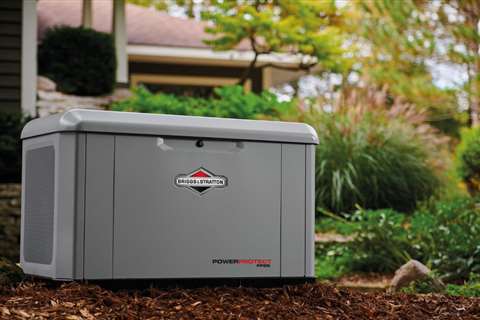 Briggs & Stratton has been a longtime competitor in the home standby power markets and Andrews said the company is “very enthusiastic about the about the opportunities that that exist in that area.”
Briggs & Stratton has been a longtime competitor in the home standby power markets and Andrews said the company is “very enthusiastic about the about the opportunities that that exist in that area.”
Certainly, you could make an argument that the trends are moving away from urbanization and people living in cities, to moving to suburbs and more remote areas. And, that trend is good for our end markets.
Our manufacturing plants continued to operate throughout the pandemic, to support our customers and to support the end markets. But we are getting back to a pre-pandemic, in-person schedule here at the headquarters and facilities around Milwaukee.
That’s important to us because we’re trying to drive culture change throughout the company, and you can’t drive that culture change working remotely. And those members of our team who are highly engaged and enthusiastic about the opportunities of this company going forward, have been itching to get back into the office.
There were strategic plans before you got here that included divesting part of the portfolio, specifically some equipment businesses. Are those plans still in place?
Andrews: From day one, we – myself, KPS Capital Partners and the board – were under no financial pressure in what we call the new Briggs & Stratton to divest any businesses.
Some of the decisions that were previously made were perhaps driven by short-term financial pressures. We believe that there are opportunities to drive growth and improvement in all aspects of the business and that’s what we intend to do.
We intend to maximize the opportunities that exist in each of our business units. We are not actively marketing any parts of this company for sale.
In 2019, Briggs & Stratton started its Vanguard Commercial battery business. How is that going?
Andrews: It’s going phenomenally well. About 10 months ago we launched our new battery facility in Tucker, Ga., and we have a very strong partnership with Club Car in Georgia to supply systems for golf cars. And we have, right now, hundreds of inquiries or active discussions with customers around the world regarding our Vanguard battery systems.
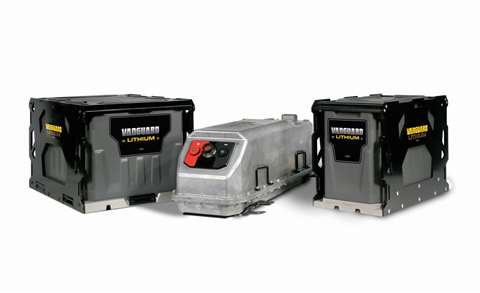 First unveiled in 2019, the Vanguard Commercial batteries have been a growing area of focus as Briggs & Stratton positions itself as a ‘power agnostic’ manufacturer.
First unveiled in 2019, the Vanguard Commercial batteries have been a growing area of focus as Briggs & Stratton positions itself as a ‘power agnostic’ manufacturer.
You will see going that this is a key area of focus for us and there’s going to be a tremendous amount of new product development around batteries and electrified systems going forward.
The other thing regarding our battery systems is while there’s tremendous interest in the outdoor power space in our traditional markets, there is also a very large level of interest across multiple different end markets and industries for our products as well.
Traditionally when people think of Briggs & Stratton, they think of outdoor power equipment (OPE). But there are tremendous opportunities for this company going forward in many different end markets and industries outside of OPE, whether it be light construction, whether it be recreation and so on.
We also very recently made a minority, but meaningful investment, in a Waterloo, Ontario, company, Accelerated Systems, Inc. (see related story). They are a designer and develop developer of not only battery systems, but motors, controllers and drive systems for electrified products.
That will help accelerate our product technology and new product development roadmap. Rather than trying to develop that competency internally over the next number of years, this is a case of making an investment to partner in order to accelerate the implementation of those technologies, both for our internal products and our offerings to our OEM customers.
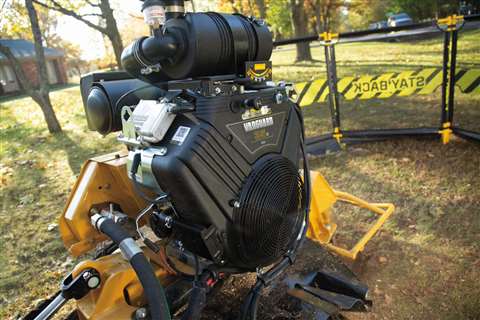 Gasoline engines such as this 35 hp Big Block V-twin, remain as a critical part of Briggs & Stratton’s power portfolio.
Gasoline engines such as this 35 hp Big Block V-twin, remain as a critical part of Briggs & Stratton’s power portfolio.
It’s those types of investments that we are very much capable of making today that a year ago, Briggs & Stratton was unable to make. The new Briggs & Stratton has the capability to continue to make those investments.
Briggs & Stratton has historically been very active is home standby power generation. What’s your take on that market?
Andrews: We are very enthusiastic about the about the opportunities that that exist in that area. We believe that is a space that is very much a growing market segment, given all the concerns that exist with reliable power supply and challenges with the grid.
I have heard from a number of people that home standby was really helped by the pandemic because people, especially those working at home, realized that their power isn’t as reliable and trouble-free as they thought it was, working on computers and everything else.
If you’re going to work at home, power is a necessity, Wi Fi is a necessity. And as the trends continue toward battery-powered automobiles, being able to charge your vehicle requires power if the grid is down.
We are very, very optimistic and very focused on growing our position in that marketplace. We have strong competitors, and we certainly believe that the growth in the market going forward can support numerous players. Briggs is committed to being an important player in that market going forward and that’s an area where we will continue to heavily invest.
In many cases, private equity does not have a good reputation for managing acquired companies. How is KPS different?
Andrews: I’ve worked with KPS since 2011 when we created IES. KPS is fundamentally about making businesses better and partnering with management teams and supporting management in all facets of the business. KPS has always been very supportive in providing appropriate levels of investment to make a business stronger, more competitive and more sustainable for the long-term.
When we divested the IES business, it became an easy decision for me to want to work with KPS again, knowing what a strong and aligned partner they had been. I’m convinced that that they’re the perfect owner for Briggs & Stratton going forward.
POWER SOURCING GUIDE
The trusted reference and buyer’s guide for 83 years
The original “desktop search engine,” guiding nearly 10,000 users in more than 90 countries it is the primary reference for specifications and details on all the components that go into engine systems.
Visit Now
STAY CONNECTED




Receive the information you need when you need it through our world-leading magazines, newsletters and daily briefings.
CONNECT WITH THE TEAM










